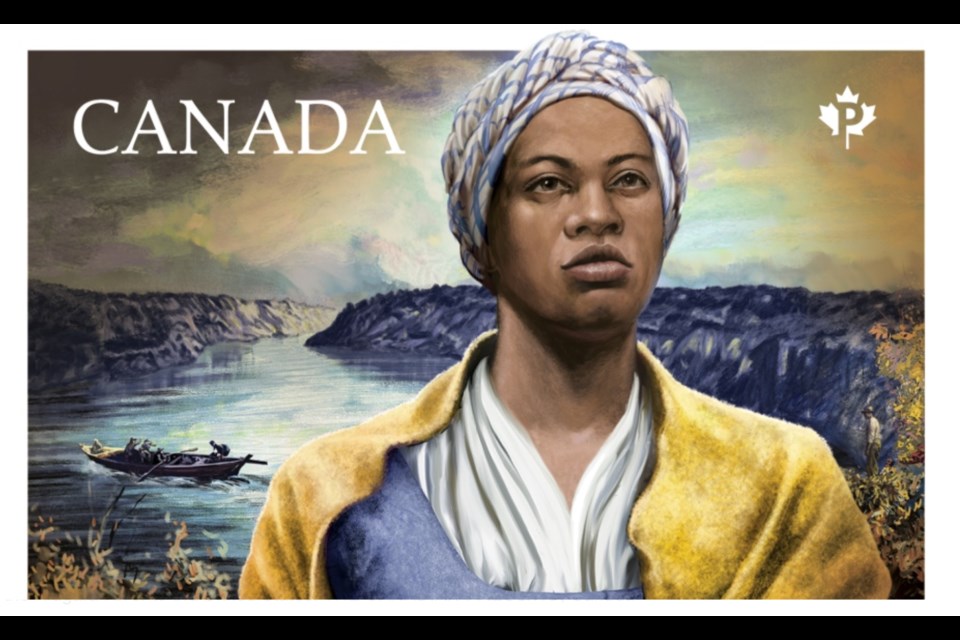An important piece of Niagara-on-the-Lake history has found its way into the world of stamp collections just in time for Black History Month.
On Jan. 29, Canada Post issued a stamp honouring Chloe Cooley, an enslaved woman in the Niagara area. In March, 1793, her enslaver, Adam Vrooman, forced her into a boat at Queenston to sell her across the Niagara River. Her screams of protest were witnessed by Black Loyalist Peter Martin, who took his concern to the Executive Council of Upper Canada.
The incident is believed to have led to Lieutenant-Governor John Graves Simcoe’s passing of the Act to Prohibit Slavery later that year. The act banned the importation of slaves into Upper Canada, a major first step in the abolition of slavery in the province.
A plaque commemorating Cooley’s importance stands today on the Niagara Parkway at what has become known as Vrooman’s Point.
“It is very special,” says Brandy Ryan, director of Equity, Diversity and Inclusion (DEI) at Canada Post. Ryan’s family settled in the early 1900s in one of the largest and most northern Black pioneer communities in Canada, Alberta’s Amber Valley.
“For me, and others who have been in Canada for many generations,” says Ryan, “it’s special for us to see that representation and commemoration of diversity. It means so much to me and my family personally, to our legacy, for all to know that there have been Black Canadians for a long time.”
Cooley’s story of fortitude, resilience and strength resonates with Ryan, who tells The Local that it was a Canada Post stamp launch in 2021 that led her to working for the crown corporation.
“They released a number of stamps for Black History Month,” Ryan explains of that year. “They featured Black Canadian communities, and one of those was Amber Valley. When I saw that stamp, it was a big deal to my family to see our community get recognized. A couple of months later I got a call from Canada Post for an opportunity, and I wanted to be a part of it.”
Ryan’s role in promoting DEI within the organization did not include being part of the decision to actually go forward with the Cooley stamp. She explains that usually a new design is created when there are multiple requests to Canada Post to honour an important Canadian figure.
Once the decision was made, though, the crown corporation reached out to experts with knowledge of the Chloe Cooley story. One of those experts, of course, was at the Niagara-on-the-Lake Museum.
Sarah Kaufman, the museum’s managing director and curator, was asked to provide input, as was educator and historian Natasha Henry, the president of the Ontario Black History Society.
“In Niagara-on-the-Lake, we know Chloe Cooley’s story,” says Kaufman, “but the rest of Canada doesn’t. I was very excited to see that they had selected her as the stamp for Black History Month this year.”
The stamp features a prominent image of Cooley in the foreground of the scenic Niagara River. The boat on which her kidnapper forcibly transported her across the river from Queenston is seen behind her right shoulder. Dark clouds loom on the horizon.
“I found some mistakes in the first design they sent,” Kaufman remembers. “The boat was wrong, it didn’t look like the Niagara River, or Queenston. So we talked back and forth with them, and I got to review the text (on the stamp package) as well.”
Kaufman is happy with the final design, created by Lime Design and featuring an illustration by Rick Jacobsen.
“It tells a story itself,” she says. “Chloe looks very defiant and strong. It demonstrates what we know from the witness accounts from the time, that she was constantly combating her situation, and rightfully so. It’s from the perspective of Vrooman’s Point. And there’s a figure watching from the grounds, representative of Peter Martin.”
Unfortunately Cooley’s life following the 1793 incident remains a mystery. Kaufman concedes that there might be a good chance Cooley herself had no idea of the impact her kidnapping had on the lives of other enslaved individuals.
“It’s a shame she might not even have known about it,” Kaufman laments.
There are other important moments in Niagara’s history that might lend themselves to future Black History Month commemorations.
“Solomon Moseby is a main character who has a significant story,” explains Kaufman. “The riot that happened around him is also something that affected change in legislation in Canada. He would be another great candidate.”
Moseby was an African-American freedom seeker who stole his enslaver’s horse and escaped to Niagara in 1837. His enslaver tracked him down with an arrest warrant and Moseby was jailed in Niagara-on-the-Lake. More than 200 members of the local Black community camped outside the jail to protest and to obstruct Moseby’s removal. Two protesters were killed during the riot. Moseby escaped and fled to England.
“Although we are a small town, we have significant national history behind us,” says Kaufman. “We’ve been involved in so many significant events locally, there are so many characters from the past that could potentially be on a stamp.”
For Ryan, it’s important that Black History Month be recognized each year, and that Canada Post continues to do its part to recognize significant moments and people.
“I didn’t learn about any of the history of my people in school,” says Ryan. “Most of my colleagues didn’t, either. For those of us who want to tell that story, we’ve been left out of the history books. Far too often those stories don’t get told. I’m excited to work for an organization that tells those stories.”
“It was quite an honour to be a part of the project,” Kaufman adds. “I got to see the light shone nationally on Niagara-on-the-Lake, and on Chloe Cooley, who is a significant part of our history.
